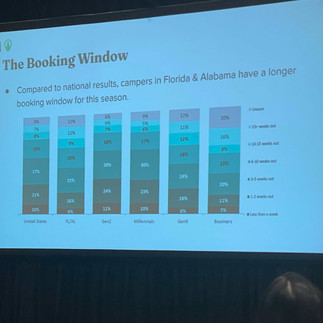Issue 21. 5.10.25
- General Manager
- May 10
- 7 min read
Behind the Scenes at Sawmill – Conference Insights (Part 1)
Often, guests and residents only see the fun, social side of Sawmill—but what’s less visible is the countless hours spent planning, workshopping ideas, and managing the business side that keeps us profitable and ranked number one.
As General Manager, one of my personal commitments is staying current on industry trends, pursuing continuing education, and building strong networks. These behind-the-scenes efforts often go unnoticed, but they are essential to our long-term success.
This week, I had the pleasure of attending the Camp Florida-Alabama Conference for the second year in a row, as well as the CAI (Community Associations Institute) Conference for the first time. Both were incredibly valuable, and I wanted to take a moment to share some of the insights I gathered during these events.
This is Part 1 of a two-part series. Here, I’ll share my notes from the sessions. In Part 2, I’ll dive into how we plan to apply what we’ve learned right here at Sawmill.
Happy reading—and as always, if you have any questions or ideas, feel free to stop by my office. I’d love to chat.
—Justin Pamplin
General Manager, Sawmill


The Sawmill Camping Resort, Spa, and Residential Community
Office of the General Manager, Justin Pamplin
May 09, 2025
Attending the 2025 Camp Florida / Camp Alabama Conference was a truly insightful experience. From the very first day, it was clear that this event would offer fresh perspectives and practical tools for campground operators like myself. But what I didn’t expect was to discover another conference happening at the same time—one focused on the HOA and community association side of the business.
I was immediately intrigued.
Without hesitation, I registered for the CAI Community Association Conference, and to be honest, it was game-changing. Being in a room full of professionals who face similar challenges in governance, community relations, and operational leadership was not only validating—it was incredibly inspiring. For the rest of the week, I split my time between both conferences, attending as many sessions as possible and absorbing knowledge from every angle.
This document reflects just a portion of the notes I compiled from those classes—lessons on leadership, innovation, marketing, technology, community building, and legislative strategy. I also took the opportunity to invest in several books that I believe will continue to support our growth. These include a Board Member Handbook, A Place to Age, Retirement Generation and Community Associations, and a refresher on Parliamentary Procedure, which I haven’t read in a few years.
What a wonderful, rejuvenating week it was. I look forward to putting these lessons into motion and welcome any board member or team member who’d like to borrow the books once I’m done. This is only part one of my report focused on the notes. The next part will focus on how it relates to us at Sawmill. Let’s keep learning—and building—a better community together.
—Justin Pamplin General Manager, Sawmill Resort
2025 Industry Conference Recap Camp Florida / Camp Alabama & CAI Community Association Institute
RV & Camping Industry Trends Summary
Florida/Alabama Conference
Performance Overview
Florida has shown resilience with a 7% increase in occupancy, outperforming national averages.
Nationwide, the camping industry is seeing a decline in participation following post-pandemic normalization.
The length of stay has remained stable, but consumer behavior around booking and accommodation preferences is rapidly evolving.
Booking Behavior & Demographics
40% of bookings now occur within 0–7 days of arrival, indicating a trend toward spontaneous travel.
Younger travelers are driving demand with a focus on:
Shared experiences
Bonding activities
More comfortable and convenient options
Accommodation Preferences
Among new campers:
31% prefer cabins/glamping
33% still opt for tents (though overall tent camping is down)
18% choose RVs
18% choose car camping
Traditional tent camping is decreasing in popularity, especially at standard 10-site campgrounds.
Geographic & International Shifts
Canadian reservations in the U.S. are down 40%:
Q1 2024: 2.86% of all reservations
Q1 2025 (projected): 1.73%
Cancellation rates from Canadian travelers: 11% vs. 7.3% U.S. average
Industry-Specific Trends
RV sales remain lower than pre-COVID projections.
Car camping and overlanding are surging in popularity.
Growing preference for:
Glamping
Boutique RV resorts
Unique destination experiences
Search Behavior & Online Presence
Decline in searches for generic terms like “camping.”
Rise in searches for “best campground” and “luxury camping.”
Indicates a more sophisticated, experience-focused demographic.
Economic Considerations
Affordability is shaping decisions:
Increase in localized travel (within driving distance)
Reduced spending per trip
Higher expectations for comfort and uniqueness
Marketing Strategy Recommendations
Focus on the Three C’s:
Comfort (upgraded cabins, spa offerings, climate control)
Convenience (easy booking, flexible dates, digital check-ins)
Cost (seasonal discounts, packages, value pricing)
Messaging should highlight immersive outdoor experiences, family/community activities, and high-end upgrades.
Thriving as a Community Association Manager (CAM)
Foundational Principles
Never throw a teammate under the bus.
Praise publicly; correct privately.
Don’t sweat the small stuff. It’s not the ER—protect your peace.
Reframing the Management Pyramid
Flip the hierarchy: Boards should treat managers as strategic advisors, not just employees.
General Managers serve as non-voting board members: guiding, advising, and implementing.
Role as Expert, Educator, Coach
Teach the association’s governance clearly.
Adapt leadership style to each board president.
Strategic ego management
Communication as a Superpower
Over-communicate; prevent confusion and litigation.
Put everything in writing. But Say “no” in person. Handle hard news face-to-face.
Culture, Community & Care
CAMs are culture leaders. Keep morale and engagement high.
As a CAM always ask yourself Am I forced to be here or Am I grateful to be here?
Strategy, Not Just Service
Shift from task-based to relationship-based leadership.
Guide ideas to readiness—help get them committee-ready.
Say yes as often as possible.
Avoid Litigation, Embrace Leadership
Talk to attorneys early.
Prevent issues with expert foresight.
Learn from every leadership experience.
Wisdom for Longevity
Protect your mental health.
Share leadership books with boards.
Remember—it’s not the jungle. You won’t be eaten alive.
Profiting from a Complaint-Free Workplace
The G.R.I.P.E. Framework
Get Attention – Complaints signal a need for connection.
Remove Responsibility – Excuses shift blame.
Inspire Envy – Bragging masked as complaint.
Power – Complaints build political coalitions.
Excuse Poor Performance – Avoid personal accountability.
Redirection Tools
“If it were possible, how would you do it?”
“It sounds like the two of you have a lot to talk about.”
“How do you plan to improve next time?”
The Complaint-Free Challenge
Goal: Go X days without complaints.
Use a bracelet or band to track habits.
Outcome: more positive, solution-focused communication.
Florida Legislative Update Summary
Session Highlights
$4 million funding request focused on back-end efficiency.
Topics: Illegal immigration, hurricane recovery, ballot initiatives, condo law reforms.
Political Context
Controversy surrounding the Hope Florida Foundation.
Key appointments:
Ashley Moody as senator
James Uthmeier as Attorney General
Jimmy Patronis running for Congress
Policy Proposals
Largest permanent tax reduction in FL history proposed.
Chief Manufacturing Officer position under review.
Grant program pending for manufacturers.
Commercial law updates via new UCC amendments.
HOA Forum Summary
Maintenance & CC&Rs
Ambiguity around responsibility (balconies, etc.)
Clear documentation and legal review essential.
Dispute Resolution
Promote mediation before litigation.
Attorney-Client Privilege
Balance transparency with legal protections.
Maintenance Matrix
Aligns responsibilities to CC&Rs.
Volunteer Burnout & Succession
Recognize contributions; plan for leadership transitions.
Board Strategy
Time-based agendas, overcommunication, and process documentation.
Revenue Management for Campgrounds
Top Line = Bottom Line
Revenue growth is more impactful than cost-cutting.
Budgeting with Market Rates
Use dynamic pricing and "starting at" language to stay competitive.
Booking Trend Analysis
If occupancy >93%, you’ve underpriced (displaced revenue).
Weekly Revenue Meetings
Review promotions, site type performance, and adjust accordingly.
Grid Optimization Defined
Strategically assign sites to minimize gaps and maximize long-term revenue.
Creative Park Experiences
This session focused on leveraging creativity and bundling to increase campground appeal. Major takeaways included:
Marketing & Segmentation: Align platforms with demographics (e.g., Gen Z = TikTok; Boomers = Facebook).
Pricing Strategy: Instead of rate cuts, offer flexible deposit and cancellation options.
All-In-One Packages: Modeled after cruise and hotel bundles, include meals, activities, and lodging.
Creative Programming: Unique ideas like ice fishing for kids, women's weekends with stylists, and food truck partnerships.
Local Curation: Build experiences around your own amenities and surroundings.
Microfinancing Options: Break up costs with monthly payment plans to increase accessibility and guest buy-in.
Midweek Programming: Attract locals and professionals through targeted weekday events.
Innovation Call: Campgrounds were encouraged to develop their own signature experiences.
Navigating Tech for Campgrounds
This session introduced practical tech tools to streamline campground operations and improve guest experience:
Tailored Tech: Avoid one-size-fits-all platforms; choose tools based on specific needs.
Communication: Utilize texting, social media, and traditional boards to reach all generations.
Recommended Software:
Spot Tonight (OTA listings)
Adventure Genie (trip planning)
Alpine Community (activity integration)
Wi-Fi Expectations: Mesh networks suggested for seamless, multi-device support.
Emerging Tools: “The Hub” and a forthcoming Google platform may reduce overall tech costs.
Call to Action: Campgrounds were invited to join forums focused on digital infrastructure improvements.
Engaging the New Campers
This session explored how to attract and retain first-time and casual campers:
Day Camping: Non-overnight experiences like crafting or cooking help introduce new audiences.
Skill Events: Off-peak programming (fire building, campfire cooking) appeals to families and younger guests.
Post-COVID Behavior: Some return to hotels, but many want easy, outdoor getaways.
Turnkey Stays: Pre-set camping experiences with minimal barriers (e.g., yurts, pre-stocked kits).
Demographic Shift: Today’s campers often have higher incomes, value convenience, and seek social, novel experiences.
Building Community in RVs
Focused on RV-specific trends and how parks can better serve this segment:
RVTI Training: Host technician training to attract DIYers and support job-seekers.
Dealer Integration: Offer “maiden voyage” events for new RV owners to create brand loyalty.
Rig Data Insights: Use national sales data to design sites by length and features.
Glamping Caution: Evaluate trends against your actual guest data before investing.
Dialogue Emphasis: Regularly verify your own data, question assumptions, and foster open discussion with RV industry partners.
Social Media for Outdoor Stays
An inspirational case study showing how digital storytelling can drive bookings and brand success:
Modern Traveler Profile: Aged 25–55, prioritizes experiences, and shares content online.
Direct Booking Wins: 80% of one company’s bookings came from social media, not OTAs.
Influencer Impact: Focus on smaller influencers with high engagement rates.
Content Best Practices: Emphasize quality, frequency, and emotional storytelling.
Future Focus: Growth in experiential, aesthetic, and wellness-based travel.
Cultivating Campground Connections
This session explored emotional engagement and community-building in camping:
Differentiator: Campgrounds offer connection, authenticity, and safety—unlike many hotels.
Learn from Competitors: Analyze glamping, Airbnb, and boondocking trends for inspiration.
Emotional Return: Emotional satisfaction leads to increased guest loyalty.
Pet-Friendly Additions: Cater to pet-owning RVers with off-leash areas, pet stations, and themed events.
Evolving Traditions: Challenge outdated programming and adapt to evolving guest expectations.
Generational Needs: Younger guests seek connection but may need onboarding into the camping lifestyle.
Peer-to-Peer: Encourage networking between guests and park owners to boost innovation and shared success.





























































Comments